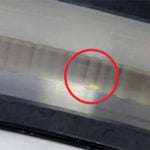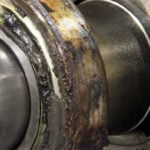When motor failure strikes, decisions must be made. Should the motor be repaired or replaced? Can the downtime be avoided by selecting a better motor?
 Do you have a pile of failed motors in your facility?
Do you have a pile of failed motors in your facility?The concept of a "throwaway" motor has come up now and again as has the question of whether it is advisable or "worth the added cost" to add bearing protection in the form of a shaft grounding ring to smaller motors.
The "throwaway" motor concept came from the thought that if the motor was not worth repairing, it should just be replaced when it fails.
In some industries, the range of what is considered a "throwaway" motor is anything under 50 HP or even 100 HP! But what are the total costs connected to a failed motor? What is the price of the new motor compared to the cost to repair? One rule of thumb I have heard is that if the repair costs are more than 60% of the new motor, then it should be replaced.
In the analysis below we look at a small 1 HP motor and its associated replacement costs. Of course as motors become larger, all costs get higher by orders of magnitude. Where a 1 HP motor can cost the facility $4,000 or more, imagine the costs for a 10 HP motor or even a 100 HP. If the motor is critical to a system, reliability becomes even more important.
These are the costs connected to a failed motor:
- Hourly rate of the person/s who must decouple the motor and remove it
- Any special rigging equipment to lift/transport the motor
- The hourly rate of management spending time on the problem
- The hourly rate of any administrative time needed to find a replacement to purchase
- Inventory costs if spare motors are stored on or off site
- Transit costs for the replacement motor when ordered or repaired
- Receiving costs when motor arrives and is stored
- Administrative time to inventory and update records
- Hourly cost of person/s re-installing the motor
- Any lifting or rigging equipment needed to transport/replace the motor
- Alignment and testing of new motor
- Vibration analysis if needed
- Disposal cost of the old motor
- PRODUCTION DOWNTIME!
A failed motor gets very expensive, and it quickly becomes clear that reducing the frequency of failure is well worth the effort.
Is it worth the effort to improve the service life by removing causes of failure?
- The motor must be replaced in any case, so why not with a "better" motor?
- If the motor must be repaired, asking if there is something which can improve its service life makes sense.
- If a new motor is selected, then finding one which lasts longer provides the best return on investment.
- Knowing the cause of failure lets you apply best practices.
- If the bearings failed from fluting damage, installing a shaft grounding ring is the answer.
When the motor is run by a variable frequency drive (VFD), which is more and more likely in today's systems, the motors are vulnerable to bearing pitting and fluting damage. The good news is that this bearing damage is an avoidable cause of bearing failure, and by the simple addition of shaft grounding rings to motors up to 100 HP (the "throwaway" motors), the problem is easily avoided. Next we will compare the failure costs associated with motors.
1) Failed 1 HP motor with NO bearing protection:
A new 1 HP motor can typically list for about $750. This motor most likely has sealed bearings and is designed for a L10 life of 60,000 hours (about 6.5 years).
So, if the motor is operated by a VFD, then the pulse width modulation will send high speed switching pulses to the motor. These voltage pulses are capacitively coupled to the rotor and will discharge through the motor's bearings, burning the grease and electrically eroding the bearing race walls until fluting occurs. Note that even before fluting, the grease is blackened. The grease's deterioration will decrease the bearing service life by 80% to 90%. This means that the bearings, which should have lasted 60,000 hours, will only last 6,000 to 12,000 hours, or less than 2 years.
OK, now for the math: To get 60,000 hours out of this motor it would need to be replaced 4 times (12,000 hours each) for a total new motor cost of $3,000. But that is not all. Each time the motor is replaced there are additional costs: Removal, disposal, shipping, administrative, alignment, and downtime.
- $3,000 in NEW motor/replacement
- $400 in removal (2 people x 50/hour x 4 replacements)
- $400 in installation (2 people x 50/hour x 4 replacements)
- $200 Disposal ($50 x 4 motors)
- $200 Management and administration
- $200 Alignment, testing, etc.
This $750 one HP motor will cost the facility an additional $4,400 in its 60,000 hour service life! Downtime cost x 4 not included.
2) Failed 1 HP motor, replacement with AEGIS shaft grounding ring installed:
After an unprotected one HP motor fails, replacing it with a motor with an AEGIS ring installed will have the following added costs:
- $910 new motor with shaft grounding ring (adding a shaft grounding ring kit to a new motor costs about $150-$200)
- $100 Removal cost
- $100 Installation cost
- $50 disposal
- $50 management/administration
- $50 alignment, testing etc.
This $750 one HP motor will cost the facility an additional $1,260 in its 60,000 hour service life! Downtime cost is 75% less.
3) Best Case scenario: The 1 HP motor had AEGIS shaft grounding rings installed at the very beginning:
If in the initial installation a one HP motor with a shaft grounding ring was selected and installed to prevent this premature bearing failure, there would only have been one cost adder:
- $60 - the difference in cost for the motor with shaft grounding ring
- Avoided: Removal cost
- Avoided: Re-Installation cost
- Avoided: disposal
- Avoided: Management/administration
- Avoided: Alignment, testing etc.
Downtime cost is ZERO!
Based on this examination it is clear that there really is no such thing as a "throwaway" motor. And even when a decision is made to replace instead of repair, it is always the most cost effective approach to select the most reliable motor.
Avoiding Down Time Lets you Rest Easy!



